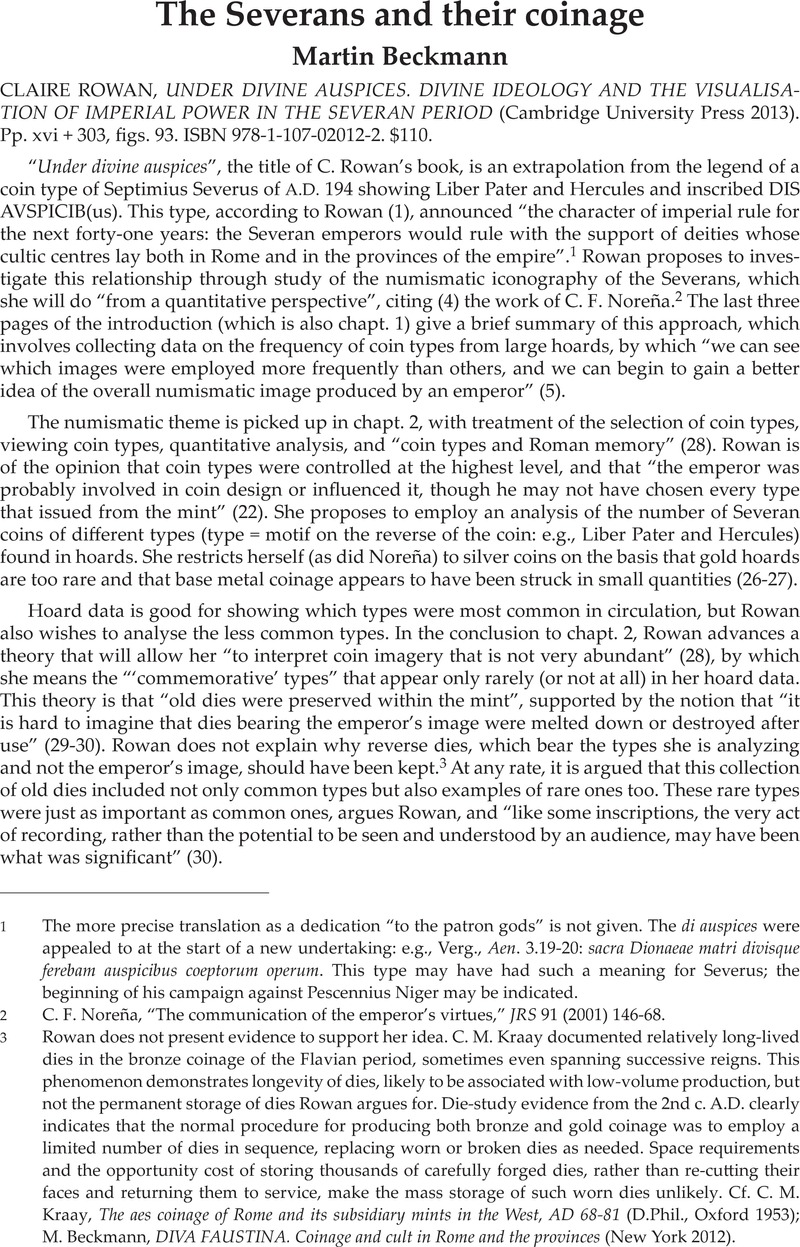No CrossRef data available.
Article contents
The Severans and their coinage - CLAIRE ROWAN, UNDER DIVINE AUSPICES. DIVINE IDEOLOGY AND THE VISUALISATION OF IMPERIAL POWER IN THE SEVERAN PERIOD (Cambridge University Press 2013). Pp. xvi + 303, figs. 93. ISBN 978-1-107-02012-2. $110.
Published online by Cambridge University Press: 27 November 2014
Abstract

- Type
- Reviews
- Information
- Copyright
- Copyright © Journal of Roman Archaeology L.L.C. 2014
References
1 The more precise translation as a dedication “to the patron gods” is not given. The di auspices were appealed to at the start of a new undertaking: e.g., Verg., Aen. 3.19-20: sacra Dionaeae matri divisque ferebam auspicibus coeptorum operum. This type may have had such a meaning for Severus; the beginning of his campaign against Pescennius Niger may be indicated.
2 Noreña, C. F., “The communication of the emperor's virtues,” JRS 91 (2001) 146–68Google Scholar.
3 Rowan does not present evidence to support her idea. C. M. Kraay documented relatively long-lived dies in the bronze coinage of the Flavian period, sometimes even spanning successive reigns. This phenomenon demonstrates longevity of dies, likely to be associated with low-volume production, but not the permanent storage of dies Rowan argues for. Die-study evidence from the 2nd c. A.D. clearly indicates that the normal procedure for producing both bronze and gold coinage was to employ a limited number of dies in sequence, replacing worn or broken dies as needed. Space requirements and the opportunity cost of storing thousands of carefully forged dies, rather than re-cutting their faces and returning them to service, make the mass storage of such worn dies unlikely. Cf. Kraay, C. M., The aes coinage of Rome and its subsidiary mints in the West, AD 68-81 (D.Phil., Oxford 1953)Google Scholar; Beckmann, M., DIVA FAUSTINA. Coinage and cult in Rome and the provinces (New York 2012)Google Scholar.
4 His work is absent from Rowan’s bibliography: cf. Halfmann, H., Itinera principum (Stuttgart 1986) 222 Google Scholar for Severus in N Africa.
5 Kleiner, D. E. E., Roman sculpture (New Haven, CT 1992) 342 Google Scholar.
6 Rowan writes (86 n.296) that she bases her description of the reliefs on a 1943 M.A. thesis by P. P. Bober.
7 Esty, W., “How to estimate the original number of dies and the coverage of a sample,” NC 166 (2006) 359–64Google Scholar.
8 Comparable die-study data for imperial denarii is rare, but Duncan-Jones, R. P. (Money and government in the Roman Empire [Cambridge 1994] 152, Table 10.5)CrossRefGoogle Scholar found a ratio of 1.9 coins per identified die in a much larger sample (147 coins) of denarii of Aelius. My own attempts to conduct die studies of denarii of Trajan and Faustina II have yielded ratios of coins to dies of barely more than 1, in sample sizes of greater than 100.
9 For another recent treatment of the iconography of Elagabalus’ coinage see Icks, M., The crimes of Elagabalus. The life and legacy of Rome's decadent boy emperor (Cambridge, MA 2012) 61–91 Google Scholar; while Icks's treatment of Elagabalus' numismatic iconography is more comprehensive that Rowan's, it is neither particularly systematic nor founded on a careful consideration of the meaning or communicative power of coin types.
10 For his methodology, see Noreña (supra n.2) 147-52 and id., Imperial ideals in the Roman West: representation, circulation, power (Cambridge 2011) 191-97.
11 This is also suggested by Rowan’s remark in the preface (xiii) characterizing her heavy use of numismatic evidence as a “deviation from my intended course”.
12 There is some inconsistency in rendering coin legends: e.g. p. 41, “DIS AVSPICIB(us)”, then “disauspicib[us]” (sic, with square brackets), then on 42, “dis auspicib”. There is also a lack of precision in describing graphs and pie-charts: these are consistently described as displaying “types as represented in hoards”, when in fact they represent number of specimens of types (graphs) or number of specimens of types expressed as a percentage of all specimens (pie-charts). In the list of figures (viii-xii) none of the many coins illustrated from the British Museum collection is identified by museum catalogue numbers.


